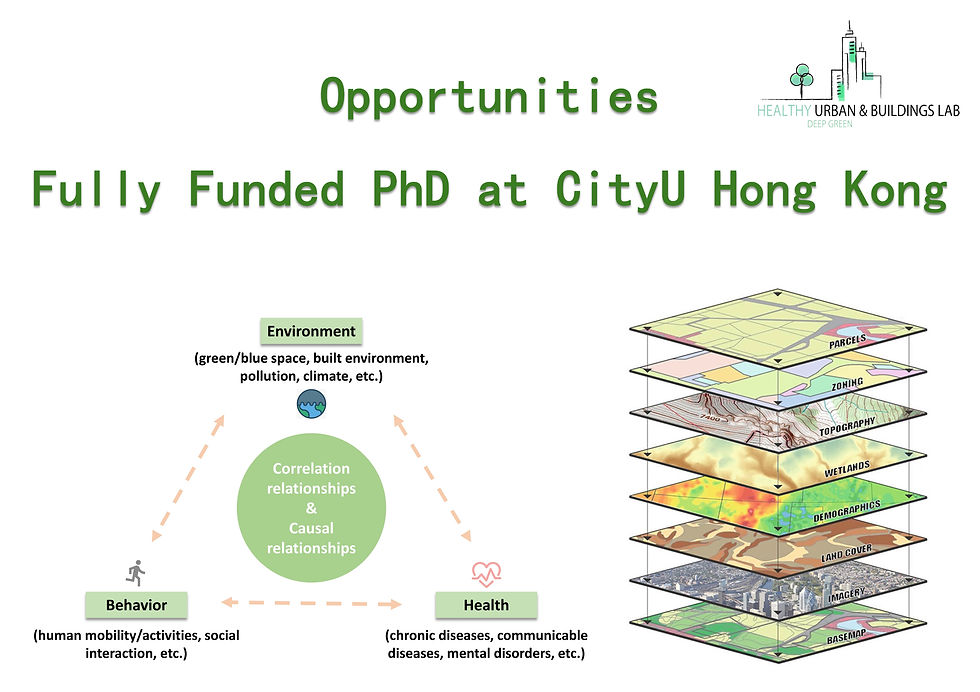

RESEARCH INTERESTS
Urban Sensing and Analytics
Drawing on diverse geo-referenced sensing data (e.g., street view images, satellite images), we aim to employ advanced urban sensing and analytics techniques (e.g., computer vision and GeoAI) to precisely assess urban built environment.
Nexus between Environment, Behavior, and Health
We excel in conducting cross-sectional studies to explore the correlation relationships between environment, behavior, and health. Additionally, we are proficient in conducting longitudinal studies to infer causal relationships.
Geospatial Big Data Mining and Spatial modelling
Leveraging multi-source geospatial big data, we aim to employ diverse GIS techniques to uncover intriguing space-time patterns and phenomenon within cities, which contributes to pursuit of sustainable urban development.

ABOUT
Urban design and architecture reflect and guide existing human experience; they also stimulate and generate new human experience. The evolution of technologies, lifestyles, culture, and pandemics continuously redefines the way in which built environment supports healthy behaviors and outcomes.
The Healthy Urban and Building Lab (HUB) develops tools, models and theories for better understanding, quantifying and evaluating the performance of built environment relative to its human behavior and health. HUB creates credible evidence linking design decisions to health outcomes and makes these findings usable for designers and decision-makers.
In lecture, funded research, consultation, training, HUB works with other universities, design firms, and policy makers to provide significant and measurable economic, social and health improvement to the built environment in many cities in China and overseas, with important follow-on impacts on the quality of citizens’ lives. HUB also contributes to the development of street design and greenspace design guidelines for several major cities in China, such as Wuhan, Nanjing, and Shanghai.
Latest Publications
-
Zhou, Y., & Lu, Y.* (2024). Health effects of greenspace morphology: Large, irregular-shaped, well-connected, and close-clustered greenspaces may reduce mortality risks, especially for neighborhoods with higher aging levels. Environmental Research, 263, 120095. (see more details)
-
Wang, J., Lu, Y.*, Diao, M., & Liu, Y. (2024). A comparative analysis of cross-sectional study and natural experiment in rail transit-travel behavior research: A case study in Wuhan, China. Journal of Transport Geography, 121, 104035. (see more details)
-
Zou, X., Zhou, Y., & Lu, Y. (2024). Addressing ‘difficulty in dining’among older adults: optimizing community senior dining halls from external and internal built environments. Humanities and Social Sciences Communications, 11(1), 1-12. (see more details)
-
Wei, D., Lu, Y.*, Zhou, Y., Ho, H. C., & Jiang, B. (2024). The effect of peri-urban parks on life expectancy and socioeconomic inequalities: A 16-year longitudinal study in Hong Kong. Landscape and Urban Planning, 252, 105192.. (see more details)
-
Wei, D., Wang, Y., Jiang, Y., Guan, X., & Lu, Y*. (2024). Deciphering the effect of user-generated content on park visitation: A comparative study of nine Chinese cities in the Pearl River Delta. Land Use Policy, 144, 107259. (see more details)
News & Events


HUB Lab director Dr. Yi Lu and PhD students Dongwei Liu, Zhenhua Li, Yuxuan Zhou attended AAG 2024 annual meeting

Congrats to Prof. Lu for being awarded as a Highly Cited Researcher in 2023!

Collaboration
HUB Lab has established collaborations with prestigious universities, including the University of Hong Kong, Southeast University, Wuhan University, Huazhong University of Science and Technology, Tianjin University, Sun Yat-sen University, Tongji University, and East China Normal University, etc. We warmly welcome interdisciplinary collaborations with teams worldwide.



